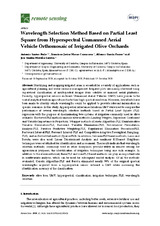Mostrar el registro sencillo del ítem
Wavelength Selection Method Based on Partial Least Square from Hyperspectral Unmanned Aerial Vehicle Orthomosaic of Irrigated Olive Orchards
| dc.contributor.author | Santos-Rufo, Antonio | |
| dc.contributor.author | Mesas Carrascosa, Francisco Javier | |
| dc.contributor.author | García-Ferrer Porras, Alfonso | |
| dc.contributor.author | Meroño de Larriva, José Emilio | |
| dc.date.accessioned | 2020-10-19T09:58:58Z | |
| dc.date.available | 2020-10-19T09:58:58Z | |
| dc.date.issued | 2020 | |
| dc.identifier.uri | http://hdl.handle.net/10396/20526 | |
| dc.description.abstract | Identifying and mapping irrigated areas is essential for a variety of applications such as agricultural planning and water resource management. Irrigated plots are mainly identified using supervised classification of multispectral images from satellite or manned aerial platforms. Recently, hyperspectral sensors on-board Unmanned Aerial Vehicles (UAV) have proven to be useful analytical tools in agriculture due to their high spectral resolution. However, few efforts have been made to identify which wavelengths could be applied to provide relevant information in specific scenarios. In this study, hyperspectral reflectance data from UAV were used to compare the performance of several wavelength selection methods based on Partial Least Square (PLS) regression with the purpose of discriminating two systems of irrigation commonly used in olive orchards. The tested PLS methods include filter methods (Loading Weights, Regression Coefficient and Variable Importance in Projection); Wrapper methods (Genetic Algorithm-PLS, Uninformative Variable Elimination-PLS, Backward Variable Elimination-PLS, Sub-window Permutation Analysis-PLS, Iterative Predictive Weighting-PLS, Regularized Elimination Procedure-PLS, Backward Interval-PLS, Forward Interval-PLS and Competitive Adaptive Reweighted Sampling-PLS); and an Embedded method (Sparse-PLS). In addition, two non-PLS based methods, Lasso and Boruta, were also used. Linear Discriminant Analysis and nonlinear K-Nearest Neighbors techniques were established for identification and assessment. The results indicate that wavelength selection methods, commonly used in other disciplines, provide utility in remote sensing for agronomical purposes, the identification of irrigation techniques being one such example. In addition to the aforementioned, these PLS and non-PLS based methods can play an important role in multivariate analysis, which can be used for subsequent model analysis. Of all the methods evaluated, Genetic Algorithm-PLS and Boruta eliminated nearly 90% of the original spectral wavelengths acquired from a hyperspectral sensor onboard a UAV while increasing the identification accuracy of the classification. | es_ES |
| dc.format.mimetype | application/pdf | es_ES |
| dc.language.iso | eng | es_ES |
| dc.publisher | MDPI | es_ES |
| dc.rights | https://creativecommons.org/licenses/by/4.0/ | es_ES |
| dc.source | Remote Sensing 12(20), 3426 (2020) | es_ES |
| dc.subject | Olive tree | es_ES |
| dc.subject | UAV | es_ES |
| dc.subject | Hyperspectral | es_ES |
| dc.subject | Classification | es_ES |
| dc.subject | Irrigation technique | es_ES |
| dc.subject | PLS | es_ES |
| dc.subject | Wavelength selection | es_ES |
| dc.title | Wavelength Selection Method Based on Partial Least Square from Hyperspectral Unmanned Aerial Vehicle Orthomosaic of Irrigated Olive Orchards | es_ES |
| dc.type | info:eu-repo/semantics/article | es_ES |
| dc.relation.publisherversion | http://dx.doi.org/10.3390/rs12203426 | es_ES |
| dc.rights.accessRights | info:eu-repo/semantics/openAccess | es_ES |

